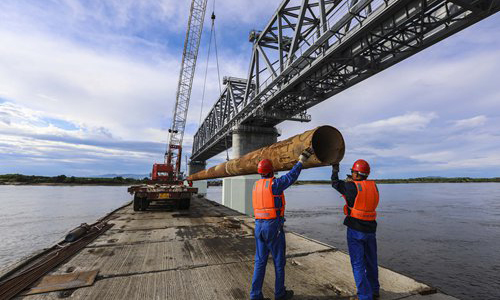
Workers transport tubes at the Tongjiang-Nizhneleninskoye Railway Bridge crossing over the Heilongjiang River (the Amur River) at Tongjiang, Northeast China's Heilongjiang Province. Photo: IC
The Sino-Russian Tongjiang-Nizhneleninskoye railway bridge is largely completed and will soon be ready to open for business, with the first test train expected to cross the border around August 26-28, the Global Times learned on Tuesday.
The bridge will become a key infrastructure facility to boost trade between China and Russia. Most of cargoes passing through the bridge will be Russian iron ore bound for China.
"There will be a Russian train coming over to the Chinese side as a test to see if everything is fine," Lin Yonghan, a project manager at the bridge, told the Global Times on Tuesday.
The railway bridge has a dual track system, which allows trains running on both the Russia gauge at 1,520 millimeters and the Chinese gauge at 1,435 millimeters, without the need to change wheels on the bridge. Russian trains will be able to run for about 15 kilometers until they reach a depot where their cargo will be shifted to Chinese trains, Lin said.
The bridge will be open to traffic in 2021, sputniknews.cn reported on Tuesday, citing a senior executive with Russian Railways, Russia's state-owned railway operator. It has been reported that the bridge will become fully operational in 2022.
Iron ore will be the main product carried across the bridge, which has an annual designed cargo capacity of 21 million tons, Lin said.
The project is one of the major railway lines being built by China, Russia and Mongolia to improve cross-border infrastructure connectivity.
Other rail connections include a branch line of the Trans-Siberian Railway connecting Russia's Chita and a land port in North China's Inner Mongolia Autonomous Region, and a rail line that's under construction in Mongolia.
China's National Development and Reform Commission said in last December such projects will improve coal shipments from Russia and Mongolia to China by leaps and bounds.
Construction started on the bridge in February 2014. It will be the first railway bridge to cross the Heilongjiang River, known as the Amur River in Russia, connecting the city of Tongjiang of Heilongjiang Province with Nizhneleninskoye in Russia.
It will reduce the cost of shipping Russian iron ore to China and shorten the trip to a major Chinese steel mill to just 233 kilometers from 1,040 kilometers, according to media reports.
In the first half of this year, Heilongjiang's trade with Russia recovered from the pandemic, with an 18.4 percent year-on-year gain to 59.95 billion yuan ($9.25 billion), according to local media reports.




